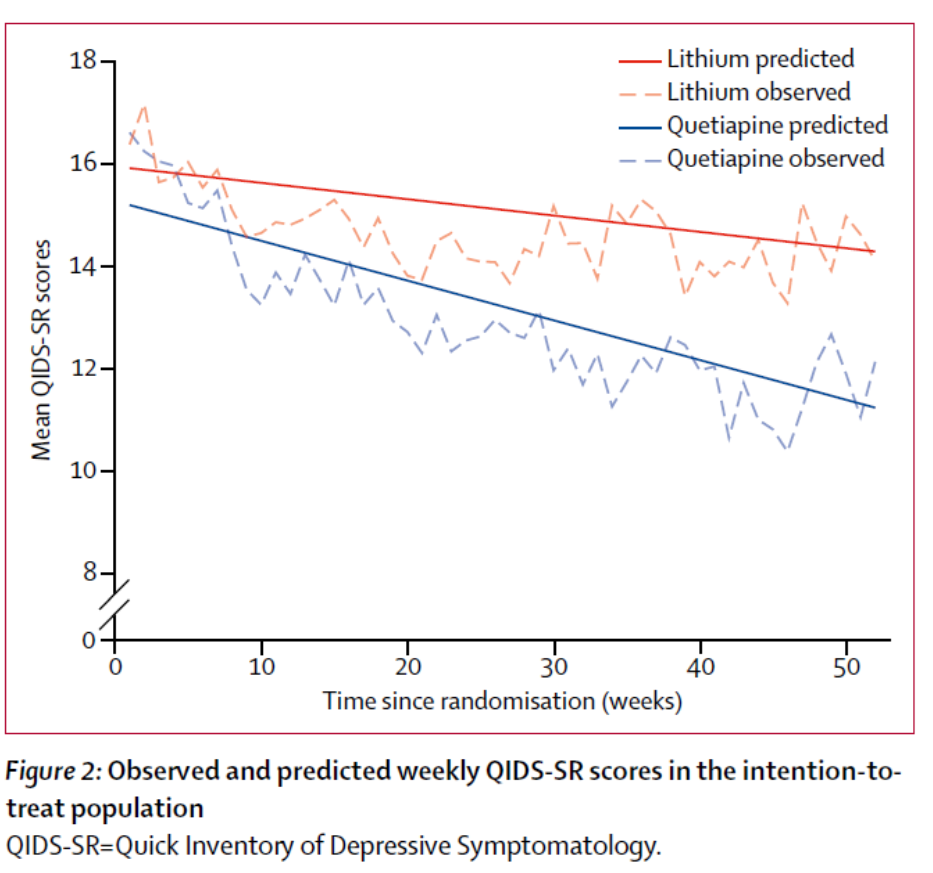The woodland has a number of blogs in relation to ‘remedy resistant despair’ a spread of matters from the affected person expertise to the fee effectiveness of interventions akin to long run psychoanalytic psychotherapy.
I put remedy resistant despair (TRD) in italics above as chances are you’ll be stunned to know that there isn’t any consensus on its definition, which in flip implies that the incidence charges differ and there aren’t any constant medical pointers in relation to remedy (Gabriel et al 2023).
The US Meals and Drug Administration and the European Medicines Company have adopted probably the most used definition of TRD (insufficient response to a minimal of two antidepressants regardless of adequacy of the remedy trial and adherence to remedy). It’s at the moment estimated that a minimum of 30% of individuals with despair meet this definition and so the burden of this facet of despair just isn’t insignificant (McIntyre R et al 2023).
The Maudsley Prescribing Tips (Taylor et al 2021) first alternative choices for administration of TRD embody augmentation with lithium and quetiapine. This weblog appears to be like on the new randomised managed trial by Prof Tony Cleare et al, revealed right now in The Lancet Psychiatry, immediately evaluating the medical and price effectiveness of the 2. This paper is especially attention-grabbing because the trial (the LQD examine (Lithium versus Quetiapine in Melancholy)) has a for much longer comply with up interval than earlier research, enabling a ‘actual life’ comparability.

The LQD examine, revealed right now within the Lancet Psychiatry compares the medical and price effectiveness of lithium and quetiapine for remedy resistant despair.
Strategies
So, this trial is a *takes a deep breath* “part 4, pragmatic, open label, parallel-group, randomised managed superiority trial, evaluating the medical effectiveness and price effectiveness of lithium versus quetiapine augmentation of antidepressant medicine in members with treatment-resistant despair.”. Let me break that down for you:
Part 4: medicine is accepted and being utilized in observe. These trials take a look at long run security and effectiveness in observe
Pragmatic: trying on the effectiveness of medicines in actual life conditions
Open label: members and researchers know which remedy the members are receiving (non-blinded examine)
Parallel group: two lively remedy teams, that are then in contrast
Randomised managed superiority trial: members had been randomly assigned to remedy teams and reviewed as to which remedy performs higher.
Medical effectiveness course of: Following random allocation to remedy, trial clinicians might resolve whether or not to proceed with prescription of the allotted medicine primarily based on pre-prescribing security checks and medical judgement. All members, no matter trial medicine standing, had been adopted up over 12 months until they actively withdrew.
The first outcomes had been:
The Fast Stock of Depressive Symptomatology (QIDS-SR) , used as a weekly measure of temper state and
Time to discontinuation of remedy.
Weekly knowledge on QIDS-SR, Work and Social Adjustment Scale (WSAS) and trial medicine standing had been collected through a web-based platform, True Colors.
Price effectiveness course of: The Consumer Service Receipt Stock was used at baseline, 8, 26, and 52 weeks. This software collects knowledge on health-care service use, together with the quantity and period of contacts with major and secondary health-care providers. High quality-Adjusted Life Years (QALYs) had been used to measure well being advantages.
Outcomes
Over a 4.5 yr interval (Dec 2016 to July 2021) 262 sufferers had been screened for eligibility from 6 NHS Trusts throughout England. The inclusion standards included:
≥ 18 years
Below the care of a GP or psychological well being service
Present depressive episode assembly DSM-5 standards for main depressive dysfunction (single or recurrent episode)
Rating of ≥ 14 on the 17 merchandise Hamilton Melancholy Ranking Scale
Insufficient response of the present episode to 2 or extra antidepressants, prescribed for a minimum of 6 weeks at therapeutic dose
Present antidepressant remedy unchanged and at therapeutic dose for a minimum of 6 weeks; and
Have been capable of present written knowledgeable consent
Exclusion standards included (however not restricted to)
Analysis of bipolar dysfunction or present psychosis
Enough use of lithium or quetiapine of their present episode
Present use of one other atypical antipsychotic.
There have been major, secondary and tertiary outcomes within the examine. For this weblog I’ll give attention to the first outcomes and notice any key outcomes from the secondary outcomes (tertiary outcomes weren’t included on this publication).
212 sufferers had been randomly assigned:
105 assigned to lithium; 21 didn’t obtain or provoke lithium however remained within the trial. 66 offered knowledge at 52 week comply with up
107 assigned to quetiapine; 12 didn’t obtain quetiapine however remained within the trial. 78 offered knowledge at 52 week comply with up
Medical effectiveness outcomes
Major outcomes
General burden of depressive symptom severity over 12 months
Time to all trigger discontinuation
Contributors within the quetiapine group had a decrease general burden of depressive symptom severity than members within the lithium group over 12 months. The QIDS-SR knowledge factors had been mapped over the yr and the realm underneath the curve calculation used as a measure of depressive symptom burden. The realm underneath the curve was smaller for Quetiapine: (space underneath the distinction curve –68.36 [95% CI –129.95 to –6.76]; p=0.0296).
Time to trial medicine discontinuation didn’t differ considerably between the 2 teams; the median time was:
365.0 days (Inter-Quartile Vary, IQR 57.0 to 365.0) within the quetiapine group
212.0 days (21.0 to 365.0) within the lithium group
Adjusted hazard ratio [HR] 0.72 [95% CI 0.47 to 1.09]; p=0.1196.
Given the large IQR and huge discrepancy between the respective medians, we should take into account this “absence of proof” moderately than “proof of absence”.
When it comes to secondary outcomes, members within the quetiapine group had considerably decrease MADRS (p=0.0435) and WSAS scores (p=0.0071) at week 52 than members within the lithium group. No important variations had been famous within the different secondary outcomes which included bodily well being parameters and opposed occasions (see paper for full particulars). An attention-grabbing destructive outcome was that no weight achieve was noticed throughout time within the quetiapine group.
Price effectiveness outcomes
In contrast with lithium, quetiapine was dominant. Prices had been decrease whereas advantages had been increased.
From an NHS and private social providers perspective, quetiapine was related to decrease price and bigger achieve in QALYs, than lithium. The incremental web well being advantage of Quetiapine was 0.097 over lithium (with any constructive outcome indicating choice to the in contrast various). Further price effectiveness evaluation can be found within the appendices of the paper which define that quetiapine is probably the most cost-effective choice based on the NICE willingness-to-pay threshold.

The quetiapine remedy group had a decrease general burden of depressive symptomatology than lithium.
Conclusions
The authors concluded that:
our findings recommend a average and clinically related advantage of quetiapine over lithium for long-term remedy of members with treatment-resistant despair.
And this examine:
…extends the earlier discovering that quetiapine is non-inferior to lithium over the brief time period and recommend superiority over the long run.

In comparison with lithium, quetiapine is probably the most cost-effective choice in relation to the NICE willingness-to-pay threshold.
Strengths and limitations
This paper has some actual strengths in that its foremost purpose was to imitate real-life medical selections and sufferers. There was lived expertise involvement in designing and operating the trial and affected person and public involvement members had been supportive of the weekly QIDS-SR assessments to offer a greater indication of the course and long-term period of final result for what could be a fluctuating medical course in remedy resistant despair (TRD). Following sufferers up for 1 yr was a giant plus.
As a result of nature of the trial, clinicians weren’t blind to allocation, nonetheless the authors report that ‘clinician rated final result measures had been assessed by masked raters and statisticians had been unaware of group allocation till the information evaluation part’ to attempt to cut back bias as a lot as potential.
With each trial there shall be limitations and this paper isn’t any exception. Having clinician judgement as as to if the allotted drugs is prescribed probably introduces allocation bias.
The affected person teams had been randomised based on diploma of remedy resistance (failure of two versus three or extra antidepressant remedies within the present episode) they usually used ‘block randomisation with randomly various block sizes’, nonetheless inside the outcomes there isn’t any reference as to what number of had been in every group or whether or not the outcomes correlated to this.
Many of the knowledge relied on self-reports. Though this technique was developed in partnership with affected person teams, the burden might have contributed to attrition.
In the course of the trial, the pattern dimension was decreased from 276 to 214 on account of challenges with recruitment. Energy calculations had been accomplished and had been 80% for time to discontinuation and 96.5% energy with an impact dimension of 0.38. It’s nonetheless unclear if the discontinuation charges, impact sizes and attrition charges had been modified from the unique planning when calculating these. There seemed to be probably regarding gaps within the 52 week assortment knowledge, extra so for lithium (37% for the lithium group and 27% for the Quetiapine group) and the authors notice substantial lacking knowledge for a few of the secondary outcomes.
General, there was a number of attrition, which ought to warning our interpretation of those outcomes. The intention to deal with evaluation solely included 66/104 and 78/107 of the lithium and quetiapine sufferers respectively. The completely different ranges of attrition in every group might imply that we’re now not evaluating like with like throughout the teams.
Lastly, the inhabitants examined was predominantly white (89%) which is able to restrict the flexibility for generalisation to all populations.

Mimicking actual life medical observe over a yr comes with it’s personal limitations.
Implications for observe
Sufferers who’ve despair which is ‘troublesome to deal with’ are ‘clinically difficult’ and undergo a big burden from the illness. Each lithium and quetiapine are widespread choices for augmentation and this paper highlights that quetiapine may very well be extra efficacious and price efficient than lithium. The size of comply with up of the examine makes this encouraging and positively price contemplating. The facility of the examine and the moderately heterogeneous group of severity might restrict leaping to a direct use of quetiapine over lithium, but when there was future replication of this examine and outcomes, then that would definitely be convincing.
The authors are clear although that Lithium stays an efficient remedy choice. It’s possible that the medicines can have completely different advantages for various folks (e.g. considerations in relation to sleep, urge for food, nervousness) and so remedy needs to be tailor-made to those wants. Nonetheless, if lithium and quetiapine are equally acceptable then quetiapine could pip lithium to the put up.
Having clear medical pointers in relation to methods for ‘troublesome to deal with’ despair and/or when it turns into ‘remedy resistant’, appears a precedence in order that future analysis may be evaluating apples with apples.
On the time of penning this, there’s a complicating think about that there’s a nationwide scarcity of modified launch quetiapine and we’re having to maneuver sufferers onto fast launch Quetiapine which has a unique facet impact profile and will not produce outcomes replicable to the examine.

Quetiapine might pip lithium to the put up if on an excellent subject.
The non-public influence of remedy resistant despair can’t be underestimated and I’m certain they’d agree with the phrases of Bon Jovi ‘I simply wish to dwell whereas I’m alive…it’s my life’.
Assertion of pursuits
I’ve no battle of pursuits to reveal
Hyperlinks
Major paper
Anthony J Cleare, Jess Kerr-Gaffney, Kimberley Goldsmith, Zohra Zenasni, Nahel Yaziji, Huajie Jin, Alessandro Colasanti, John R Geddes, David Kessler, R Hamish McAllister-Williams, Allan H Younger, Alvaro Barrera, Lindsey Marwood, Rachael W Taylor, Helena Tee, and on behalf of he LQD Examine Group. (2025) Medical and cost-effectiveness of lithium versus quetiapine augmentation for treatment-resistant despair in England: a practical, open-label, parallel-group, randomised managed superiority trial. The Lancet Psychiatry 2025. DOI: 10.1016/S2215-0366(25)00028-8
Different references
Gabriel FC et al (2023) Tips’ suggestions for the treatment-resistant despair: A scientific overview of their high quality. PLoS ONE 18(2): e0281501.
McIntyre RS, et al (2023) Remedy-resistant despair: definition, prevalence, detection, administration, and investigational interventions. World Psychiatry. (2023) 22, no. 3, 394–412.
Taylor, David M, et al. The Maudsley Prescribing Tips in Psychiatry. 14th ed., John Wiley & Sons, 2021 pg 318-319.
Photograph credit
Source link



